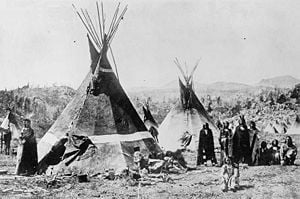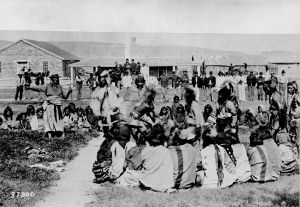Difference between revisions of "Shoshone" - New World Encyclopedia
({{Claimed}}) |
(141210001) |
||
| Line 1: | Line 1: | ||
{{Claimed}} | {{Claimed}} | ||
| + | [[Category:Politics and social sciences]] | ||
| + | [[Category:Anthropology]] | ||
| + | |||
| + | |||
| + | {{Citations missing|date=April 2007}} | ||
| + | [[Image:Shoshoni tipis.jpg|right|thumb|300px|Shoshone around their [[tipi]], probably taken around 1890]] | ||
| + | [[Image:Shoshone_indians.jpg|thumb|300px|"Shoshone Indians at Ft. Washakie, Wyoming Indian reservation. Chief Washakie (at left) extends his right arm." Some of the Shoshones are dancing as the soldiers look on, 1892.]] | ||
| + | {{about|the Native American tribe}} | ||
| + | |||
| + | |||
| + | |||
| + | The '''Shoshone''' are a Native American tribe with three large divisions: the Northern, the Western and the Eastern. The Northern concentrated in eastern [[Idaho]], western [[Wyoming]], and north-eastern [[Utah]]. The Eastern lived in Wyoming, northern [[Colorado]] and [[Montana]]. Conflict with the [[Blackfoot Indians|Blackfoot]], [[Crow Indians|Crow]], [[Lakota people|Lakota]], [[Cheyenne Indians|Cheyenne]]s, and [[Arapaho]]s pushed them south and westward after about 1750. The Western ranged from central Idaho, northwestern Utah, central [[Nevada]], and in [[California]] about [[Death Valley]] and [[Panamint Valley]]. This group is sometimes called the Panamint. The Idaho groups of Western Shoshone were called Tukuaduka, or Sheep Eaters while the Nevada/Utah ones were called the Gosiute and the Toi Ticutta (cattail eaters). | ||
| + | |||
| + | The estimated population of Northern and Western Shoshone was 4,500 in 1845. 3,650 Northern Shoshone and 1,201 Western Shoshone were counted in 1937 by the United States Office of Indian Affairs. | ||
| + | |||
| + | The Shoshone lived in mainly New Mexico and Arizona. | ||
| + | |||
| + | The Northern Shoshone fought conflicts with settlers in Idaho in the 1860s which included the [[Bear River Massacre]] and again in 1878 in the [[Bannock War]]. They fought with the U.S. Army in the 1876 [[Battle of the Rosebud]] against their traditional enemies, the Lakota and Cheyenne. | ||
| + | |||
| + | In 1982, the Western Shoshone, who also invited "unrepresented tribes", made a declaration of [[sovereignty]] and began issuing its own [[passport]]s as the Western Shoshone National Council. | ||
| + | |||
| + | ==Reservations== | ||
| + | [[Image:Rabbit-Tail.jpg|thumb|right|Rabbit-Tail]] | ||
| + | *[[Wind River Reservation]], population 2,650 Eastern Shoshone, 2,268,008 acres (9,178 km²) of reservation in [[Wyoming]] are shared with the Northern [[Arapaho]] | ||
| + | *[[Fort Hall Indian Reservation]], 544,000 acres (2,201 km²) in [[Idaho]], Lemhi and Northern Shoshone with the [[Bannock Indians]], a Paiute band with which they have merged | ||
| + | *[[Lemhi Indian Reservation]] (1875–1907) in Idaho, Lemhi Shoshoni, removed to Fort Hall Reservation | ||
| + | *[[Duck Valley Indian Reservation]], southern Idaho/northern Nevada, Western Shoshone | ||
| + | *[[Ely Shoshone Indian Reservation]] in [[Ely, Nevada]], 111 acres (0.45 km²), 500 members | ||
| + | *[[Fallon Reservation and Colony]], [[Fallon Paiute-Shoshone]] tribe, near [[Fallon, Nevada]], 8,200 acres (33 km²), 991 members, Western Shoshone and Paiute | ||
| + | *[[Goshute Indian Reservation]], 111,000 acres (449 km²) in Nevada and Utah, Western Shoshone | ||
| + | *[[Skull Valley Indian Reservation]], 18,000 acres (73 km²) in [[Utah]], Western Shoshone | ||
| + | *[[Fort McDermitt Indian Reservation]], Nevada and Oregon, Fort McDermitt Paiute and Shoshone Tribe | ||
| + | *[[Reno-Sparks Indian Colony]], Nevada, 1988 acres (8 km²), total 481 member of Shoshone, Paiute, and [[Washoe (tribe)|Washoe]] bands | ||
| + | *[[Duckwater Indian Reservation]], located in Duckwater, Nevada, approximately 75 miles from Ely. | ||
| + | *[[Nevada Shoshone Indian Reservation]], near Carson City, Nevada, 211 members | ||
| + | |||
| + | ==See also== | ||
| + | * [[Shoshone language]] | ||
| + | * [[Western Shoshone traditional narratives]] | ||
| + | |||
| + | ==External links== | ||
| + | *[http://64.233.187.104/search?q=cache:4TG28N221AYJ:www.trailtribes.org/lemhi/making-treaties.htm+Fort+Bridger+Treaty+Council+of+1868&hl=en Northern Shoshoni Treaties] | ||
| + | *[http://college.hmco.com/history/readerscomp/naind/html/na_035900_shoshone.htm Detailed history] | ||
| + | *[http://www.greatbasinheritage.org/elyshoshone.htm Ely Shoshone] | ||
| + | *[http://www.fpst.org/thetribe/thetribe.htm Fallon Paiute-Shoshone] | ||
| + | *[http://www.greatbasinheritage.org/goshute.htm Goshute Indians] | ||
| + | *[http://www.gbcnv.edu/gbia/ Great Basin Indian Archives] | ||
| + | *[http://www.rsic.org/ Reno-Sparks Indian Colony] | ||
| + | *[http://shoshone.us General Shoshone resource] | ||
| + | *[http://www.temoaktribe.com/ Te-Moak Tribe of the Western Shoshone Indians of Nevada] | ||
| + | *[http://timbisha.org/ Timbisha Tribe of the Western Shoshone Nation] | ||
| + | *[http://www.nativeweb.org/pages/legal/shoshone/ruby_valley.html U.S. Treaty with the Western Shoshone 1863, Ruby Valley] | ||
| + | *[http://www.wsdp.org/ Western Shoshone Defense Project] | ||
| + | |||
| + | {{credits|Shoshone|141210001}} | ||
Revision as of 05:42, 18 July 2007

- This article is about the Native American tribe. For other uses of the term, see Shoshone (disambiguation).
The Shoshone are a Native American tribe with three large divisions: the Northern, the Western and the Eastern. The Northern concentrated in eastern Idaho, western Wyoming, and north-eastern Utah. The Eastern lived in Wyoming, northern Colorado and Montana. Conflict with the Blackfoot, Crow, Lakota, Cheyennes, and Arapahos pushed them south and westward after about 1750. The Western ranged from central Idaho, northwestern Utah, central Nevada, and in California about Death Valley and Panamint Valley. This group is sometimes called the Panamint. The Idaho groups of Western Shoshone were called Tukuaduka, or Sheep Eaters while the Nevada/Utah ones were called the Gosiute and the Toi Ticutta (cattail eaters).
The estimated population of Northern and Western Shoshone was 4,500 in 1845. 3,650 Northern Shoshone and 1,201 Western Shoshone were counted in 1937 by the United States Office of Indian Affairs.
The Shoshone lived in mainly New Mexico and Arizona.
The Northern Shoshone fought conflicts with settlers in Idaho in the 1860s which included the Bear River Massacre and again in 1878 in the Bannock War. They fought with the U.S. Army in the 1876 Battle of the Rosebud against their traditional enemies, the Lakota and Cheyenne.
In 1982, the Western Shoshone, who also invited "unrepresented tribes", made a declaration of sovereignty and began issuing its own passports as the Western Shoshone National Council.
Reservations
- Wind River Reservation, population 2,650 Eastern Shoshone, 2,268,008 acres (9,178 km²) of reservation in Wyoming are shared with the Northern Arapaho
- Fort Hall Indian Reservation, 544,000 acres (2,201 km²) in Idaho, Lemhi and Northern Shoshone with the Bannock Indians, a Paiute band with which they have merged
- Lemhi Indian Reservation (1875–1907) in Idaho, Lemhi Shoshoni, removed to Fort Hall Reservation
- Duck Valley Indian Reservation, southern Idaho/northern Nevada, Western Shoshone
- Ely Shoshone Indian Reservation in Ely, Nevada, 111 acres (0.45 km²), 500 members
- Fallon Reservation and Colony, Fallon Paiute-Shoshone tribe, near Fallon, Nevada, 8,200 acres (33 km²), 991 members, Western Shoshone and Paiute
- Goshute Indian Reservation, 111,000 acres (449 km²) in Nevada and Utah, Western Shoshone
- Skull Valley Indian Reservation, 18,000 acres (73 km²) in Utah, Western Shoshone
- Fort McDermitt Indian Reservation, Nevada and Oregon, Fort McDermitt Paiute and Shoshone Tribe
- Reno-Sparks Indian Colony, Nevada, 1988 acres (8 km²), total 481 member of Shoshone, Paiute, and Washoe bands
- Duckwater Indian Reservation, located in Duckwater, Nevada, approximately 75 miles from Ely.
- Nevada Shoshone Indian Reservation, near Carson City, Nevada, 211 members
See also
- Shoshone language
- Western Shoshone traditional narratives
External links
- Northern Shoshoni Treaties
- Detailed history
- Ely Shoshone
- Fallon Paiute-Shoshone
- Goshute Indians
- Great Basin Indian Archives
- Reno-Sparks Indian Colony
- General Shoshone resource
- Te-Moak Tribe of the Western Shoshone Indians of Nevada
- Timbisha Tribe of the Western Shoshone Nation
- U.S. Treaty with the Western Shoshone 1863, Ruby Valley
- Western Shoshone Defense Project
Credits
New World Encyclopedia writers and editors rewrote and completed the Wikipedia article in accordance with New World Encyclopedia standards. This article abides by terms of the Creative Commons CC-by-sa 3.0 License (CC-by-sa), which may be used and disseminated with proper attribution. Credit is due under the terms of this license that can reference both the New World Encyclopedia contributors and the selfless volunteer contributors of the Wikimedia Foundation. To cite this article click here for a list of acceptable citing formats.The history of earlier contributions by wikipedians is accessible to researchers here:
The history of this article since it was imported to New World Encyclopedia:
Note: Some restrictions may apply to use of individual images which are separately licensed.


